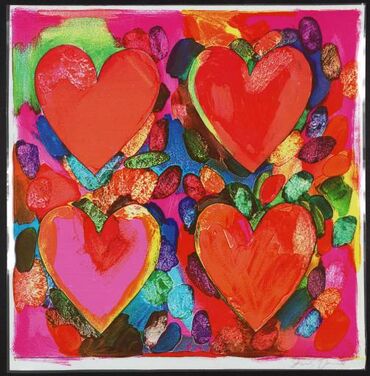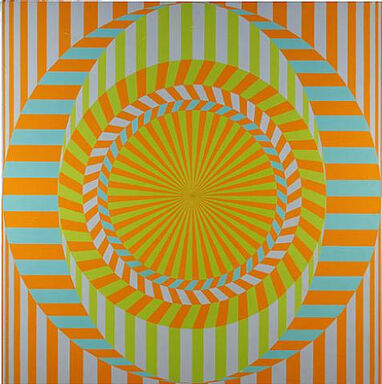There was a lot going on in the sixties in the cultural and political world — new genres in art, music, literature, politics. A treasure trove of ideas. Below are some sixties trends/genres, any of which could lend itself to the subject for your project.
The hope is that something catches your eye. For suggestions about how to do art projects, which are related to the artists illustrated, check out articles on Methods and under artists names.
Art Movements of the 1960's[]
POP Art[]

Jim Dine, 4 Hearts
Repetition, Commercialization, Mass Production — those were the over-arching themes of POP artists. For a general overview of POP art, Wikipedia is always a good place to start. http://en.wikipedia.org/wiki/Pop_art.
The standard potted description of Pop art on the internet is as follows:
- Pop Art emerged in the mid 1950s in England, but realized its fullest potential in New York in the '60s where it shared, with Minimalism, the attentions of the art world. In Pop Art, the epic was replaced with the everyday and the mass-produced awarded the same significance as the unique; the gulf between ``high art and ``low art was eroding away. The media and advertising were favorite subjects for Pop Art's often witty celebrations of consumer society. Perhaps the greatest Pop artist, whose innovations have affected so much subsequent art, was the American artist, Andy Warhol (1928-87).
- The term ``Pop Art was first used by the English critic Lawrence Alloway in a 1958 issue of Architectural Digest to describe those paintings that celebrate post-war consumerism, defy the psychology of Abstract Expressionism, and worship the god of materialism. The most famous of the Pop artists, the cult figure Andy Warhol, recreated quasi-photographic paintings of people or everyday objects.
From Warhol, we usually think of Pop art in terms of Campbell's soup cans, Marilyn Monroe in screen prints, and Warhol's self-portraits... But there were lots of other pop artists, indeed, some of them even....women (but very very few !).
For children's art projects on pop art on our Pop Goes the Gala Wikia:
- Warhol Portraits For Every Age
- On the Methods page, you can also find work by Sister Corita Kent
Op(tical Illusion) Art[]

Radiant Eclipse by Edna Andrada
Op Art, as the name suggests, plays with the eye/brain to create optical illusions. Kids love to projects in Op art ± the problem is that while the projects a hugely fun, they are rarely have the sort of beauty that the professional works have. (I know some people with disagree with me.) I think that the reason for this iis that illusions take great precision to create—evenly spaced very straight lines, etc. And the sort of "go for it" and niave beauty that comes with children's art doesn't lend itself very well to the precision of Op Art. Or that's what I think. I really hope that some prove me wrong!
There is one page up on this Wikia on perhaps the most famous of Op artists, Vasarely. I've found some simple and stunning prints by Vasarely, that would make great starting points for an Op art themed project.
You can find this link at: Vasarely Cooperative Canvas.
Minimalism[]
I love minimalism and surprisingly some kids do too. Certainly it's very popular once again, with the revival of mid-centruay modernism (think NOOD, Inform Design, Design Within Reach, etc.). Minimalism is not representational — they are not pictures OF anything, and they are not meant in evoke an emotion of a particular kind. In that way they are quite mysterious — they are profoudly attractive to the eye and the soul, simply in virtue of being, well, what they are. Minimalist works play with colour, form and composition—and they can be highly planned and intellectual (e.g. Albers) or created using a far more intuitive method (e.g. Rothko).
I hope to put a number of Minimalist-themed projects up — at least one on Albers and on famous Canadian minimalist, Agnes Martin. COMING SOON.